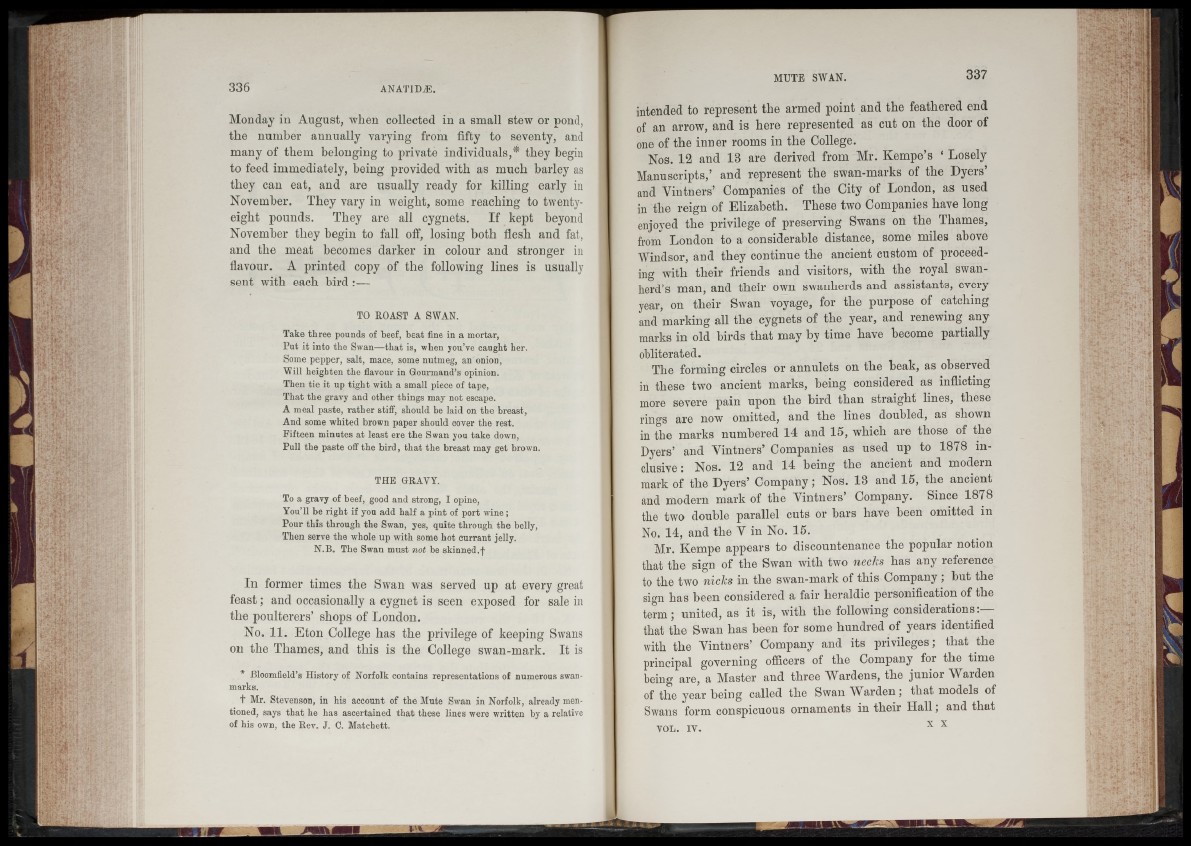
Monday in August, when collected in a small stew or pond,
the number annually varying from fifty to seventy, and
many of them belonging to private individuals,* they begin
to feed immediately, being provided with as much barley as
they can eat, and are usually ready for killing early in
November. They vary in weight, some reaching to twenty-
eight pounds. They are all cygnets. If kept beyond
November they begin to fall off, losing both flesh and fat,
and the meat becomes darker in colour and stronger in
flavour. A printed copy of the following lines is usually
sent with each bird:—
TO ROAST A SWAN.
Take th r e e pounds of beef, b e a t fine in a mortar,
P u t i t in to th e Swan— th a t is, when you’ve cau g h t her.
Some p ep p er, sa lt, mace, some nutmeg, an onion,
Will h eig h ten th e flavour in Gourmand’s opinion.
Then tie i t u p tig h t w ith a small piece of tape,
T h a t th e gravy an d o th e r th in g s may n ot escape.
A meal p aste, r a th e r stiff, should be la id on th e b reast,
And some w h ited brown p ap e r should cover th e rest.
F ifte e n m in u tes a t le a st ere th e Swan you ta k e down,
P u ll th e p aste off th e b ird , th a t th e b re a st may g et brown.
TH E GRAVY.
To a gravy of beef, good an d strong, I opine,
You’ll be r ig h t if you ad d h a lf a p in t of p o rt w in e ;
P o u r th is th ro u g h th e Swan, yes, q u ite th ro u g h th e belly,
Then serve th e whole u p w ith some h o t c u rra n t jelly.
N.B . The Swan m u st not be sk in n e d .f
In former times the Swan was served up at every great
feast; and occasionally a cygnet is seen exposed for sale in
the poulterers’ shops of London.
No. 11. Eton College has the privilege of keeping Swans
on the Thames, and this is the College swan-mark. It is
* Bloomfield’s H isto ry of Norfolk contains rep re se n ta tio n s of numerous swan-
marks.
+ Mr. Stevenson, in his account of th e Mute Swan in Norfolk, already mentioned,
says th a t he h as asce rta in ed th a t th e se lines were w ritte n by a relative
of h is own, th e Rev. J. C. M a tch e tt.
intended to represent the armed point and the feathered end
of an arrow, and is here represented as cut on the door of
one of the inner rooms in the College.
Nos. 12 and 13 are derived from Mr. Kempe’s ‘ Losely
Manuscripts,’ and represent the swan-marks of the Dyers’
and Vintners’ Companies of the City of London, as used
in the reign of Elizabeth. These two Companies have long
enjoyed the privilege of preserving Swans on the Thames,
from London to a considerable distance, some miles above
Windsor, and they continue the ancient custom of proceeding
with their friends and visitors, with the royal swan-
herd’s man, and their own swanherds and assistants, every
year, on their Swan voyage, for the purpose of catching
and marking all the cygnets of the year, and lenewing any
marks in old birds that may by time have become partially
obliterated.
The forming circles or annulets on the beak, as observed
in these two ancient marks, being considered as inflicting
more severe pain upon the bird than straight lines, these
rings are now omitted, and the lines doubled, as shown
in the marks numbered 14 and 15, which are those of the
Dyers’ and Vintners’ Companies as used up to 1878 inclusive:
Nos. 12 and 14 being the ancient and modern
mark of the Dyers’ Company; Nos. 13 and 15, the ancient
and modern mark of the Vintners’ Company. Since 1878
the two double parallel cuts or bars have been omitted in
No. 14, and the V in No. 15.
Mr. Kempe appears to discountenance the popular notion
that the sign of the Swan with two necks has any inference
to the two nicks in the swan-mark of this Company ; but the
sign has been considered a fair heraldic personification of the
term; united, as it is, with the following considerations
that the Swan has been for some hundred of years identified
with the Vintners’ Company and its privileges; that the
principal governing officers of the Company for the time
being are, a Master and three Wardens, the junior Warden
of the year being called the Swan Warden; that models of
Swans form conspicuous ornaments in their Hall; and that
v Y
YOL. IY.